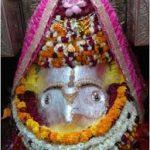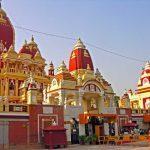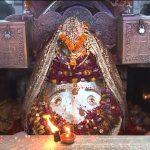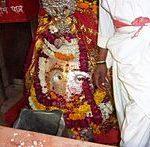Contents
Kalka Mandir, South
| Date built: | Sat Yuga |
|---|---|
| Deity: | – |
| Architectural style: | Hindu temple architecture |
| Major festivals | Navratri |
| Locale: | Kalkaji Mandir (Delhi Metro)South Delhi |
| District:: | South |
| Address: | Ma Anandmayee Marg, NSIC Estate, Block 9, Kalkaji, New Delhi, Delhi 110019 |
| Phone | – |
Architecture
The temple complex, as it stands today, is constructed of brick masonry, finished with plaster and marble and is surrounded by a pyramidal tower. The central chamber which is 12-sided in plan, 24 feet across, with a doorway in each side, is paved with marble and is surrounded by a verandah 8’9″ wide and contains 36 arched openings or exterior doorways. This verandah encloses the central chamber from all sides. At the middle of this arcade, opposite the eastern doorway, are two red sandstone tigers sitting on a marble pedestal. Both the pedestal, as well as the marble railings, contain Nastaʿlīq inscriptions of recent origin. Between the tigers there is stone image of Kali Devi with her name engraved on in Hindi, and a trident of stone standing before it.
The temple complex is situated on the Delhi Metro between the Nehru Place bus terminus and business centre and Okhla railway station and industrial area, and next to the Bahá’í Lotus Temple. Close to the temple, on a hill in the east of Kailash Colony and near the ISKCON temple, lies an edict of Ashoka, dating from the 3rd century BC.
Legend / Local stories
Millions of years ago, the gods who dwelt in the neighbourhood of the present temple were troubled by two giants and were compelled to prefer their complaint to Lord Brahma, ‘the god of all’. But Lord Brahma declined to interfere, and referred them to the Goddess Parvati. Out of the mouth of Maa Parvati sprung Kaushki Devi, who attacked the two giants and slaughtered them, but it so happened, that as their blood fell on the dry earth thousands of giants came into life, and the battle was maintained by Kaushki Devi against great odds. Maa Parvati took compassion on her offspring and out of the eyebrows of Kaushki Devi came maa Kali Devi, ‘whose lower lip rested on the hills below and the upper lip touched the sky above. She drank the blood of the slaughtered giants as it poured out of their wounds; and the goddess obtained a complete victory over their enemies. Maa Kali Devi then fixed her abode here, and she was worshipped as the chief divinity of the place.
It is believed that the Goddess Kalkaji, pleased with the prayers offered and rituals performed by the gods on the advice of Lord Brahma, appeared at the site of temple and blessed them, and settled at the site. During the Mahabharata, Lord Krishna and the Pandavas are said to have worshipped Kali at this temple during the reign of Yudhisthir. The temple itself is believed to have been constructed by Thok Brahmins and Thok Jogians at the request of Kali.
It is also called Jayanti Peetha or Manokamna Siddha Peetha. “Manokamna” literally means desire, “Siddha” means fulfilment, and “peetha” means shrine. So, it is believed to be the holy shrine where one gets the blessings of Maa Kalika Devi
Photo Gallery
How to Reach:
Contact Details
Official Address





